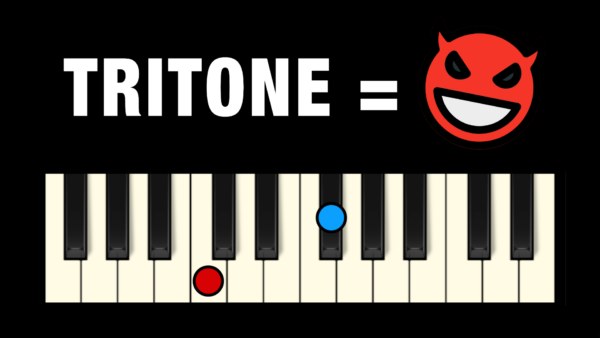 Have you ever heard of the devil in music? For a long time in music history it was even avoided completely, because if its extreme tension and harmonic dissonance. It was literally referred to as ‘diabolus in musica’, which is latin for The Devil in Music.
Have you ever heard of the devil in music? For a long time in music history it was even avoided completely, because if its extreme tension and harmonic dissonance. It was literally referred to as ‘diabolus in musica’, which is latin for The Devil in Music.
Why the Tritone is The Devil in Music
Let’s learn why the tritone is so extremely dissonant, but also how you can use it to your advantage in your music.
Important Facts about the Tritone
- Tritone Interval= 6 semitones (3 Tones)
- Tritone Names = Augmented 4th, diminished 5th
- Tritone Chords = dim, dim 7, and all b5 chords
The Tritone is the Black Sheep
The Tritone is an interval in between 2 Perfect Intervals. This is the main reason why it feels so harmonically dissonant. Because above it you have the Perfect 5th interval, which is 7 semitones. And the mirror image of the perfect 5th is the perfect 4th, which is 5 semitones. Both of these intervals have a very stable harmonic sound. But what if you go in-between them? That is where you will find the odd one, the black sheep, the devil of music. And it is called the Tritone.
How to use the Tritone in Your Music
Now for the fun part, let’s check out how you can use the Tritone in your music. Because we don’t live in the days of the past anymore, where the tritone was practically banned by the church.
- Use Diminished Chords for High Tension
- Add Flat 5th Chords for Mystery
- Create a Tritone Melodic Leap for Bizarre
- Dance around the Tritone for Dark Action
- Riff with the m2 in the Bass for Evil Boss
Examples of the Tritone in Action
There are plenty of examples of music using the tritone to take advantage of its devil sound, black sheep oddity, or simply quirky and spooky mood. Here are some famous examples:
- Alien – Main Theme
- Metallica – Enter Sandman
- The Simpsons – Main Theme
- South Park – Main Theme
- Dance Macabre by Camille Saint-Saëns

